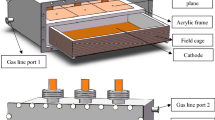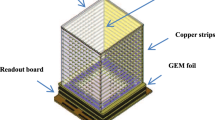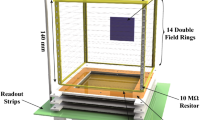Abstract
Purpose
Low-radioactive material screening is becoming essential for rare event search experiments, such as neutrinoless double beta decay and dark matter searches in underground laboratories. A gaseous time projection chamber (TPC) can be used for such purposes with large active areas and high efficiency.
Methods
A gaseous TPC with a Micromegas readout plane of approximately \(20 \times 20\) \(\hbox {cm}^2\) is successfully constructed for surface alpha contamination measurements.
Results
We have characterized the energy resolution, gain stability, and tracking capability with calibration sources.
Conclusion
With the unique track-related background suppression cuts of the gaseous TPC, we have established that the alpha background rate of the TPC is (\(0.13\pm 0.03\))\(\times 10^{-6}\) Bq/\(\hbox {cm}^2\), comparable to the leading commercial solutions.














Similar content being viewed by others
References
M. Agostini, G. Benato, J. Detwiler, Discovery probability of next-generation neutrinoless double- \(\beta \) decay experiments. Phys. Rev. D 96(5), 053001 (2017). https://doi.org/10.1103/PhysRevD.96.053001. arXiv:1705.02996 [hep-ex]
M.J. Dolinski, A.W.P. Poon, W. Rodejohann, Neutrinoless double-beta decay: status and prospects. Ann. Rev. Nucl. Part. Sci. 69, 219–251 (2019). https://doi.org/10.1146/annurev-nucl-101918-023407. arXiv:1902.04097 [nucl-ex]
J. Liu, X. Chen, X. Ji, Current status of direct dark matter detection experiments. Nat. Phys. 13(3), 212–216 (2017). https://doi.org/10.1038/nphys4039. arXiv:1709.00688 [astro-ph.CO]
J. Billard et al., Direct detection of dark matter–APPEC committee report. Rept. Prog. Phys. 85(5), 056201 (2022). https://doi.org/10.1088/1361-6633/ac5754. arXiv:2104.07634 [hep-ex]
N. Abgrall et al., The Majorana demonstrator radioassay program. Nucl. Instrum. Meth. A 828, 22–36 (2016). https://doi.org/10.1016/j.nima.2016.04.070. arXiv:1601.03779 [physics.ins-det]
D.S. Leonard et al., Trace radioactive impurities in final construction materials for EXO-200. Nucl. Instrum. Meth. A 871, 169–179 (2017). https://doi.org/10.1016/j.nima.2017.04.049. arXiv:1703.10799 [physics.ins-det]
Z. Qian et al., Low radioactive material screening and background control for the PandaX-4T experiment. JHEP 06, 147 (2022). https://doi.org/10.1007/JHEP06(2022)147. arXiv:2112.02892 [physics.ins-det]
X. Chen et al., PandaX-III: searching for neutrinoless double beta decay with high \(\text{ pressure}^{136}\)Xe gas time projection chambers. Sci. China Phys. Mech. Astron. 60(6), 061011 (2017). https://doi.org/10.1007/s11433-017-9028-0. arXiv:1610.08883 [physics.ins-det]
C. Alduino et al., The projected background for the CUORE experiment. Eur. Phys. J. C 77(8), 543 (2017). https://doi.org/10.1140/epjc/s10052-017-5080-6. arXiv:1704.08970 [physics.ins-det]
H. Zhang et al., Dark matter direct search sensitivity of the PandaX-4T experiment. Sci. China Phys. Mech. Astron. 62(3), 31011 (2019). https://doi.org/10.1007/s11433-018-9259-0. arXiv:1806.02229 [physics.ins-det]
R. Bunker et al., The BetaCage, an ultra-sensitive screener for surface contamination. AIP Conf. Proc. 1549(1), 132–135 (2013). https://doi.org/10.1063/1.4818093. arXiv:1404.5803 [physics.ins-det]
H. Ito, K. Miuchi, K. Kobayashi, Y. Takeuchi, K.D. Nakamura, T. Ikeda, H. Ishiura, Alpha-ray imaging chamber based on a micro-TPC in a low radioactivity structure. J. Phys. Conf. Ser. 1468(1), 012233 (2020). https://doi.org/10.1088/1742-6596/1468/1/012233
H.-Y. Du et al., Screener3D: a gaseous time projection chamber for ultra-low radioactive material screening. Nucl. Sci. Tech. 32(12), 142 (2021). https://doi.org/10.1007/s41365-021-00983-y. arXiv:2107.05897 [physics.ins-det]
J. Pan, Z. Zhang, C. Feng, D. Wang, R. Zhang, S. Liu, An ultra-low background alpha detection system with a Micromegas-based time projection chamber. Rev. Sci. Instrum. 93(1), 013303 (2022). https://doi.org/10.1063/5.0070612
Y. Giomataris, P. Rebourgeard, J.P. Robert, G. Charpak, MICROMEGAS: a high granularity position sensitive gaseous detector for high particle flux environments. Nucl. Instrum. Meth. A 376, 29–35 (1996). https://doi.org/10.1016/0168-9002(96)00175-1
H. Lin et al., Design and commissioning of a 600 L time projection chamber with microbulk micromegas. JINST 13(06), 06012 (2018). https://doi.org/10.1088/1748-0221/13/06/P06012. arXiv:1804.02863 [physics.ins-det]
J. Feng, Z. Zhang, J. Liu, B. Qi, A. Wang, M. Shao, Y. Zhou, A thermal bonding method for manufacturing micromegas detectors. Nucl. Instrum. Methods Phys. Res. Sect. A 989, 164958 (2021). https://doi.org/10.1016/j.nima.2020.164958
M. Fu, S.G. Wang, C. Cheng, Y. Meng, Z. Qian, X. Ning, L. Si, M. Wu, Y. Yao, Investigation of radioactive radon daughters removal methods from copper surface. Nucl. Tech. 44(2), 20502–020502 (2021). https://doi.org/10.11889/j.0253-3219.2021.hjs.44.020502
Z. Qian, et al., Low radioactive material screening and background control for the PandaX-4T experiment (2021) arXiv:2112.02892 [physics.ins-det]
S. Liu, C. Feng, C. Li, J. Dong, H. Chen, Z. Chen, J. Pan, Development of the front-end electronics for PandaX-III prototype TPC. IEEE Trans. Nucl. Sci. 66(7), 1123–1129 (2019). https://doi.org/10.1109/TNS.2019.2907125. arXiv:1806.09257 [physics.ins-det]
S. Anvar, P. Baron, B. Blank, J. Chavas, E. Delagnes, F. Druillole, P. Hellmuth, L. Nalpas, J.L. Pedroza, J. Pibernat, E. Pollacco, A. Rebii, N. Usher, Aget, the get front-end ASIC, for the readout of the time projection chambers used in nuclear physic experiments. In: 2011 IEEE Nuclear Science Symposium Conference Record, pp. 745–749 (2011). https://doi.org/10.1109/NSSMIC.2011.6154095
R. Veenhof, Garfield, a drift chamber simulation program. Conf. Proc. C 9306149, 66–71 (1993)
R. Veenhof, Garfield - simulation of gaseous detectors. https://garfield.web.cern.ch/garfield/ (2010)
M. Oreglia, A study of the reactions \(\psi ^\prime \rightarrow \gamma \gamma \psi \). Phd thesis, Stanford University (1980)
K. Altenmüller et al., REST-for-Physics, a ROOT-based framework for event oriented data analysis and combined Monte Carlo response. Comput. Phys. Commun. 273, 108281 (2022). https://doi.org/10.1016/j.cpc.2021.108281. arXiv:2109.05863 [physics.comp-ph]
ORTEC Part No. 932505: Alpha Mega Ensemble–Integrated Alpha Spectrometer Hardware User’s Manual. https://www.ortec-online.com/-/media/ametekortec/manuals/a/alpha-duo-mega-ensemble-mnl.pdf
S. Agostinelli et al., GEANT4-a simulation toolkit. Nucl. Instrum. Meth. A 506, 250–303 (2003). https://doi.org/10.1016/S0168-9002(03)01368-8
XIA: UltraLo-1800 alpha particle counter. https://xia.com/products/ultralo-1800/
Acknowledgements
This work was supported by the grant from the Ministry of Science and Technology of China (No. 2016YFA0400302) and the grant U1965201 from the National Natural Sciences Foundation of China. We appreciate the support from the Chinese Academy of Sciences Center for Excellence in Particle Physics (CCEPP).
Author information
Authors and Affiliations
Corresponding author
Ethics declarations
Conflicts of interest
The authors declare that there is no conflict of interest.
Rights and permissions
Springer Nature or its licensor (e.g. a society or other partner) holds exclusive rights to this article under a publishing agreement with the author(s) or other rightsholder(s); author self-archiving of the accepted manuscript version of this article is solely governed by the terms of such publishing agreement and applicable law.
About this article
Cite this article
Du, H., Du, C., Han, K. et al. A gaseous time projection chamber with Micromegas readout for low-radioactive material screening. Radiat Detect Technol Methods 7, 90–99 (2023). https://doi.org/10.1007/s41605-022-00364-y
Received:
Revised:
Accepted:
Published:
Issue Date:
DOI: https://doi.org/10.1007/s41605-022-00364-y




